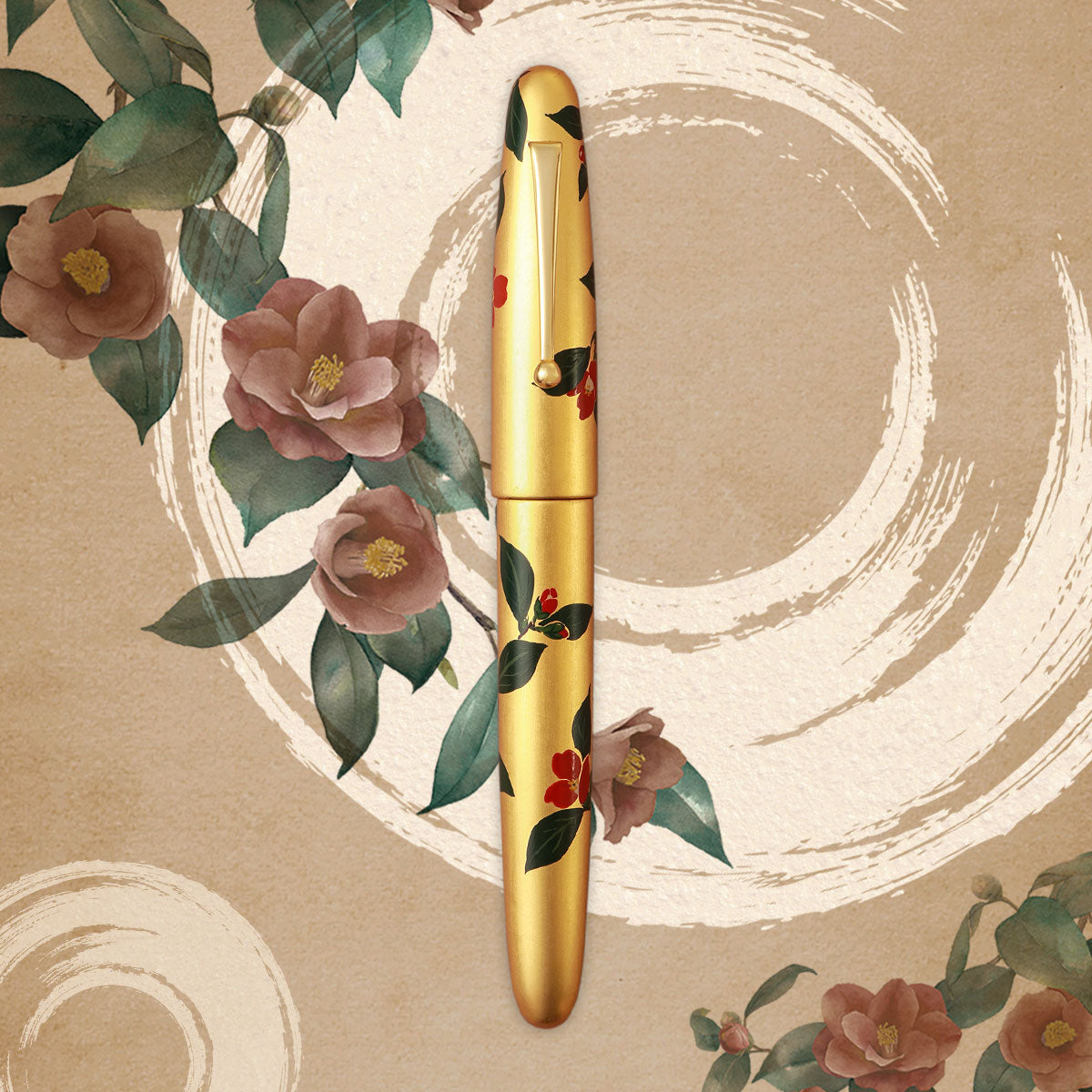Hirota Urushi - Kinpaku Maki-e - Tsubaki
Hirota Urushi - Kinpaku Maki-e - Tsubaki
Couldn't load pickup availability
Description
Description
Important Notice: The hand-making process makes every single pen a unique one; there is no pen exactly resembling one another. The one you will receive might be slightly different from the one here in the pictures, but if you appreciate the beauty of hand-craftsmanship, you will be happy with the pen we've made for you.
Hirota Urushi
Hirota Urushi is the Japanese traditional Urushi art hand-crafted by master Hirota Yoko (廣田洋子). Master Hirota's artworks are unique in designs and techniques, which are hard to find among common Urushi lacquerware.
There are 4 main techniques normally used in Master Hirota's art:
- 櫛目堆漆塗 (Kushime Tsuishitsu Nuri)
- 金箔 (Kinpaku)
- 石目堆漆塗蒟醤 (Ishime Tsuishitsu Nuri)
- 金彩ひび塗 (Kinsai Hibi Nuri)
Fountain pens from Hirota collection are handmade one by one and require years to create. Therefore, each design is limited to only 1-3 pieces.
Kinpaku
Kinpaku is the technique of laying thin gold leaves on art objects, writing tools, tableware, and religious objects. This is done to refine and polish the appearance.
Kinpaku Maki-e Collection
Master Hirota's artisan fountain pen design is a testament to meticulous craftsmanship and unwavering attention to detail. In her latest creation, she weaves a narrative of storytelling through meticulously hand-drawn Maki-e, artfully depicting the enchanting beauty of flora.
Embracing Nature's Imperfections
In the realm of pen craftsmanship, every stroke bears the discerning touch of Master Hirota. Her drawing captures botanical wonders with a meticulous eye for detail. When exploring the intricate world of Maki-e, one cannot help but notice the delicate nuances: overlapping leaves, tender sprouts, moss on tree bark, even leaves nibbled by caterpillars - no minuscule element escapes her gaze.
While some may assume that only flawlessly pristine florals meet her exacting standards, Master Hirota perceives perfection through imperfection, finding a beauty that resonates with nature's authenticity.
Pen Design: Tsubaki (Camellia)
As Master Hirota observes the cyclical nature of the Camellia flower in her garden, she reflects on its unique characteristics and imparts her wisdom. She explains that the Tsubaki flower, even in its withered state, possesses an unwavering determination. The Tsubaki, she elaborates, chooses to wither when it decides to and remains in full bloom when it so desires. This ability to assert its own lifecycle showcases the flower's innate autonomy and self-awareness.
The excellence of the Tsubaki is unassuming, marked by its noble and dignified appearance, yet it remains humble in its demeanor. This essence is beautifully captured by the Japanese saying "Hikaemena Subarashisa" (控えめな素晴らしさ), which encapsulates the concept of low-key excellence. The Camellia flower epitomizes this notion, exuding magnificence without ostentation.
In Master Hirota's Kinpaku Maki-e fountain pen, the beauty of the Tsubaki is immortalized. The design embodies the qualities of humility, determination, and unpretentious elegance that the Camellia flower embodies. Through the intricacies of the Maki-e technique, the pen serves as a tangible representation of Tsubaki's essence, capturing its inherent grace and understated allure.
With every stroke of the pen, the essence of the Tsubaki flower is brought to life, allowing the beholder to experience its unique blend of determination, unpretentious beauty, and humble nobility.
Pen Body
The whole body of the pen is covered with gold leaf sheet or Kinpaku with more than one layer. Therefore, delicate care for the body is highly recommended. Like every Urushi pen, Hirota Kinpaku Maki-e pens must be stored in a low-humidity environment and must be refrained from long exposure to direct sunlight to protect their color.
The original design by Master Hirota's inspiration came from her very own garden. Every day the plant is on her side, passing the time together.
About Master Hirota Yoko
With a great interest in traditional handmade crafts since elementary school, Master Hirota decided to choose this path and developed a strong passion for Japanese Urushi-making traditions. Master Hirota now has more than 30 years of hands-on experience in making Urushi and Maki-e.
Hirota's artwork focus on the stylish minimalism and durability of the objects. Either it's a pair of chopsticks that serve everyday meals, or it's an ornament used in the palace, it must last long and express the aesthetics of Japan's art.

Specifications
Material & art: Ebonite, Urushi, Kinpaku, Maki-e
Filling mechanism: Converter or Cartridge (European International Standard)
Nib: #6 Jowo stainless steel, Wancher 18K gold
Feed: Plastic, ebonite black, ebonite red
Compact air-tight cap: Preven dried-out ink problem

Size & Shape

Packaging
Traditional Japanese Wooden Box + Cartridge & Converter + Instructional Materials
Share















